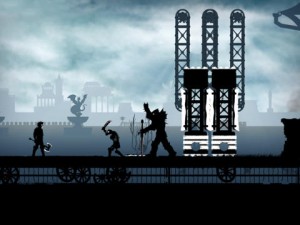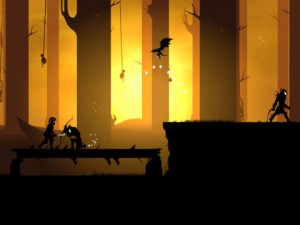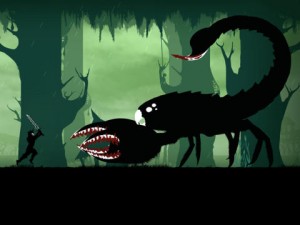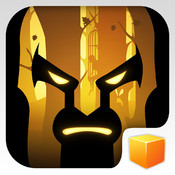You might remember a while back when we covered Mingle Games and their Kickstarter pitch to obtain the additional funds they needed to take their demo of Dark Lands, a stylish endless runner based on Sword and Sorcery traditions, to the next level of polish. Although their pleas were initially met with a positive response — securing roughly 40% of their goal in just the first ten days — things somehow quickly went sour afterwards, with not a single bit of additional progress obtained by the time their fundraiser ended. Now normally a failed Kickstarter would be where someone’s story comes to an abrupt stop, but — for the talented lot of programmers over at Mingle Games — their legacy instead continued onwards due to their project eye catching the eyes of BulkyPix.
 So then, we are now left with the obvious question of whether or not Dark Lands (out now, $2.99) still managed — despite their failed Kickstarter — to be everything that Mingle Games originally claimed it would be back in February. Right off the bat, I can safely say that the various additional world regions — as well as the entire 40 level fixed stage campaign mode — were indeed all added to their endless runner just as they promised. Although it’s quite possible that some of you tried out Mingle Games’ previous free demo, I will be continuing onwards with the assumption that you haven’t yet previously tried Dark Lands.
So then, we are now left with the obvious question of whether or not Dark Lands (out now, $2.99) still managed — despite their failed Kickstarter — to be everything that Mingle Games originally claimed it would be back in February. Right off the bat, I can safely say that the various additional world regions — as well as the entire 40 level fixed stage campaign mode — were indeed all added to their endless runner just as they promised. Although it’s quite possible that some of you tried out Mingle Games’ previous free demo, I will be continuing onwards with the assumption that you haven’t yet previously tried Dark Lands.
The basic premise of Dark Lands — as previously mentioned — is that it’s an endless runner based on Sword and Sorcery derived traditions, coupled with a stylish silhouette driven art style. In it players will have to either slay or avoid monsters — evade diabolical traps — all while collecting the gems littering the area, so that they might eventually acquire better gear for their next journey into these monster conquered realms. What particularly sets this game apart from other endless runners is that there are usually two-to-three valid responses to everything in the Dark Lands, allowing for far more freedom than normal.
Swiping up and down will permit a player to jump or slide respectively, while swiping up again — while already mid-air — will permit players to perform a powerful enemy avoiding double jump. Meanwhile, holding down a finger on both sides of the screen will cause your warrior to stand still until you let go — which can be very valuable for avoiding traps — as well as also making him block any incoming minor attacks. Finally, tapping the right hand side of the screen will cause your hero to lash out with his blade at whatever foul abominations might lay before his path (with some weapons being faster than others).
 One thing that largely differentiates Dark Lands from the many other endless runners containing an attack mechanic is that here you will come to a dead stop, without dying in the process, whenever you encounter an opponent. You and your foe will — once stopped — then begin attempting to block each others attacks up until one of you finally bites the dust, with the game — assuming you won — returning to normal afterwards. Although I previously mentioned that you will often be able to leap over enemies directly, you will sometimes also be able to cleverly trigger traps so that they maim their creators instead.
One thing that largely differentiates Dark Lands from the many other endless runners containing an attack mechanic is that here you will come to a dead stop, without dying in the process, whenever you encounter an opponent. You and your foe will — once stopped — then begin attempting to block each others attacks up until one of you finally bites the dust, with the game — assuming you won — returning to normal afterwards. Although I previously mentioned that you will often be able to leap over enemies directly, you will sometimes also be able to cleverly trigger traps so that they maim their creators instead.
The fact that often have two-to-three viable methods of tackling monsters — direct combat, complete avoidance, and activating their own traps upon them — makes Dark Lands truly unique amongst endless runners, where problems normally have only one solution each. Whereas players seeking speed could simply avoid their enemies entirely, someone trying to maximize their crystal collection would instead strive to take down each and every last foe (of which the truly clever can do without even putting themselves in harm’s way). This degree of freedom becomes particularly relevant when attempting to tackle the three unique challenges assigned to each of the many stage’s in Dark Lands’ non-randomized campaign mode.
Although Dark Lands certainly contains the requisite randomly generated endless mode that is expected of all endless runners, the game also contains 40 different short levels with fixed layouts. Each of these levels will have three special challenges that reward a ton of gems when completed, and most of these challenges are designed so that they can’t possibly all be finished simultaneously within a single run. Players will need plan their reactions to everything as there’s a big difference between finishing a stage in under fifty seconds, versus killing everything while still having over 90% of your health remaining.
 These gems can then — in turn — be used to purchase a variety of equipment that will empower you in various ways: more health, improved melee speed, as well as more melee damage. They can also be used to acquire an extra life whenever you should find that your warrior has unfortunately come to an untimely end that you find yourself refusing to accept. Although these gems can be freely obtained when picked up — or by completing the aforementioned missions, which unfortunately can only be done once each — they can also be bought via IAPs (as well as gem magnets and gem doublers).
These gems can then — in turn — be used to purchase a variety of equipment that will empower you in various ways: more health, improved melee speed, as well as more melee damage. They can also be used to acquire an extra life whenever you should find that your warrior has unfortunately come to an untimely end that you find yourself refusing to accept. Although these gems can be freely obtained when picked up — or by completing the aforementioned missions, which unfortunately can only be done once each — they can also be bought via IAPs (as well as gem magnets and gem doublers).
While the natural progression of gem acquisition doesn’t entirely destroy Dark Lands — like it can in some other endless runners — it certainly can often slow it down heavily, which some might not be happy about coming from a game that has an upfront price tag. Although there is a rhythm to the game’s combat — and usually multiple ways to tackle any given situation — it’s easy to believe that Dark Lands is instead full of cheap shots, especially when the omnipresent specter of IAPs has been strung so noticeably overhead. It might have helped if the game’s tutorial had bothered to explain the finer points of blocking and attack timing, rather than merely letting struggling players assume that it was deliberately made impossible to force them to win by opening their wallets instead.
One of these places where the brutal nature of Dark Lands’ difficulty is most likely to make itself heavily known occurs whenever the player encounters one of the game’s many bosses for the first time. Happening roughly every 300 yards in endless mode – and also at the end of specific stages in story mode – these fearsome Totem Keepers can’t be skipped, so killing them becomes the only option. As they all feature instant kill tactics – which most other monsters lack – players will need to face these foes many times before they can properly learn their patterns, and the tutorials don’t really help here either.
Anyways — game play matters and IAP concerns aside — I would now like to take a moment to discuss Dark Lands’ graphics, which have certainly managed to succeed wholeheartedly. The harsh silhouette against parallax backgrounds certainly gives Dark Lands the stylish and oppressive air that it needed to truly push forward its Sword and Sorcery motif, especially when it sprays stuff in red whenever something takes damage. It furthermore doesn’t hurt that surrounding you, also in silhouette, are an abundance of bodies hanging from hooks — trapped inside cages — as well as impaled upon spikes, making sure its quite well known just how dark and uncertain these times truly are.
iFanzine Verdict: Dark Lands is a very stylish endless runner, paying proper tribute to the brutal nature of Sword and Sorcery pulp literature, all while giving players far more freedom than found in most other endless runners. Where as most other games in the genre have precisely one reaction to each situation, here players can regularly avoid their enemies — stab them with their weapons — over even trigger traps upon them. However, Dark Lands’ heavily grind based upgrades — coupled with a less than stellar tutorial — will likely leave some feeling that this game is only about pushing IAPs, and thus possibly push them to quit long before they figure out the game’s finer points.


